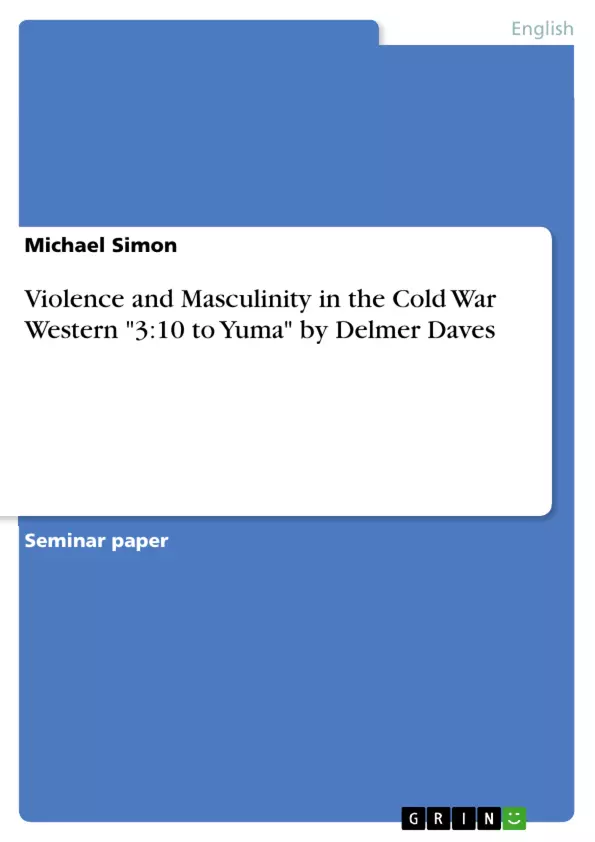In this paper I want to describe how the Cold War shaped the depiction of violence, masculinity and society in the movie “3:10 to Yuma”. I will argue that this movie not only criticizes the Korean War and the Cold War in general, but I will also showcase how societal anxieties of an escalation, for example in the form of a nuclear strike, are processed. I will argue that the idealism of Cold War liberalism, which stands in stark contrast to communism, is shown in this movie and that it shapes the way masculinity is portrayed and favored. In this way, the movie can be analyzed as a mirror both of societal processes and anxieties, and perceptions of ideal masculinity of the American culture in the 1950s.
Table of Contents
- Introduction
- Depiction of violence as Cold War criticism
- Masculinity in 3:10 to Yuma
- Résumé
- Works Cited
Objectives and Key Themes
This paper aims to analyze the depiction of violence and masculinity in the 1957 western film "3:10 to Yuma" by Delmer Daves, exploring how the Cold War shaped these elements within the film's narrative. The paper will argue that the film not only critiques the Korean War and the Cold War more broadly but also examines societal anxieties surrounding potential escalation, including the possibility of nuclear warfare. Additionally, the paper will demonstrate how the film showcases the idealism of Cold War liberalism and its influence on the portrayal of masculinity.
- The portrayal of violence in "3:10 to Yuma" as a reflection of Cold War anxieties.
- The film's critique of the Korean War and its depiction of the psychological impact of violence.
- The representation of masculinity in the film and its connection to Cold War liberalism.
- The exploration of societal anxieties regarding nuclear warfare and the consequences of military escalation.
- The film's portrayal of violence as a necessary evil in a world where pacifism could have fatal consequences.
Chapter Summaries
- Introduction: This chapter provides context for the analysis of "3:10 to Yuma" by introducing the historical backdrop of the Cold War and the Korean War. It establishes the film's setting and introduces the main characters, Dan Evans and Ben Wade. It also highlights the key themes of violence, masculinity, and societal anxieties explored in the film.
- Depiction of violence as Cold War criticism: This chapter analyzes the film's depiction of violence as a reflection of the national mood during the Cold War era. It argues that the film's portrayal of violence is deliberate and symbolic, commenting on the anxieties and debates surrounding war and the use of firearms. The chapter examines specific instances of violence in the film, highlighting the significance of each gunshot and exploring the film's message about the potentially fatal consequences of idealized pacifism. It also discusses the film's engagement with Cold War liberalism and its critique of Cold War xenophobia and militarism.
Keywords
The primary focus of this analysis lies in the themes of violence, masculinity, and Cold War anxieties as they are portrayed in the film "3:10 to Yuma". Key concepts include Cold War liberalism, the Korean War, societal anxieties surrounding nuclear warfare, the portrayal of violence as a necessary evil, and the film's critique of Cold War xenophobia and militarism.
- Citar trabajo
- Michael Simon (Autor), 2016, Violence and Masculinity in the Cold War Western "3:10 to Yuma" by Delmer Daves, Múnich, GRIN Verlag, https://www.grin.com/document/960684



